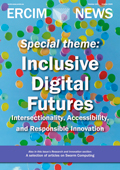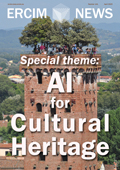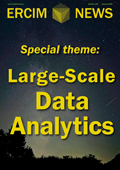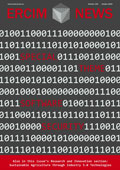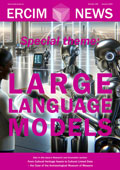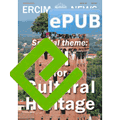by Christophe Ponsard, Caroline Djambian, Emrick Poncet
The current AI revolution is shaking up the cultural world and its creation process. In computer museums AI can be seen both as a powerful curatorial tool and an artefact requiring careful processing. We present and illustrate here the dual roles of AI in enhancing museum preservation and storytelling by providing a few specific scenarios, while being part of the story itself and raising concerns about cultural authenticity and ethics.
Artificial Intelligence (AI) has a long history prior to its current boom resulting from the combination of deep learning algorithms, powerful hardware, and huge training datasets. It is increasingly being adopted by curators as a tool to operate their museums with several reported uses [1]. Interestingly, for computer museums, AI is also worth being analysed and presented as part of the computer storyline itself, especially as the leadership in evolution appears to be shifting from humanity to AI, raising profound ethical questions about an entity devoid of consciousness yet driven by financial interests.
From a historical perspective, a typical museum presentation could be Figure 1, revealing that the current revolution, seen as disruptive, is the result of successive innovation cycles over several decades. It can also be related to other enabling revolutions such as micro-electronics, big data and learning algorithms. More specific views could also focus on key people, on the move from circles of experts to the general public, and on environmental and societal impacts. AI is also strongly reshaping culture by its ability to generate text, pictures, music, and videos triggering debates about creativity, biases, deepfakes, meddling and even humanity.
![Figure 1: AI timeline (source [L1]).](/images/stories/EN141/ponsard1.png)
Figure 1: AI timeline (source [L1]).
Many missions and daily activities of a museum can be supported by AI tools:
- For preservation: support inventory efforts by aiding artefact identification through image recognition, leveraging the public web and shared museum collections. Use text generation models (LLM) fed with technical databases to produce documentation drafts.
- For research and exhibition, create alternative thematic pathways for exploring exhibitions, offering diverse perspectives as outlined above.
- For education: use text and image generative AI to develop material adapted for school or family events, including gamification activities, also achieving multilingual support.
Of course, the use of AI should be prepared and supervised. As a detailed use case, let’s consider the main exhibition of the NAM-IP museum located in Belgium [L2]. The full visit follows a raw timeline of about 700 events covering technological discoveries, computing machines, innovations, failure stories, and general context. Currently, only a few viewpoints are proposed to the public as it is hard work. However, generative AI can produce them in a few seconds to suggest a museum tour focusing on a given technology (e.g. punch card machine), country (e.g. UK) or topic (e.g. security, AI). Raw text output can be transformed in static or dynamic visualization, e.g. with vis.js [L3] as shown in Figure 2 for punched card technology.
However special care is required: if not correctly prompted, the chatbot might inject information from uncontrolled sources or even hallucinate. It can introduce bias but can also help the curator to detect potential existing ones (e.g. in our case women were underrepresented in the existing timeline). This means the process should be guided and cross checked by human experts.
To learn to address such issues, we are pursuing our work through the ITinHeritage research project, backed by an international network of science or computing museums. Together, we explore the possibilities offered by AI aided by open data, semantic web, and Virtual Reality (VR) [L4]. So far, our collaboration has allowed us to aggregate European computing cultural heritage metadata into a Knowledge Graph and make it available as Linked Open Data (LOD). By structuring it with a diachronic domain ontology, we could enhance its meaning and improve the quality of AI processing [2]. On this basis, we also aim to apply AI techniques on extended corpora, to generate historical models of computer science evolution, supporting the work of historians and museums. This will give the opportunity to compare the completion of LLMs with ontologies constructed by experts, and to observe its biases with regard to historical facts that can be verified by experts with the help of ontology and timeline navigation operators [3]. We will then attempt to derive forward-looking visions of technological developments. Our aim is to use AI to position museums as actors of a science in the making, and not just as collectors of memory. The results produced by the AI could be made available to the public on the web, in VR or in museums. In this way, we want to provide museums with significant assistance in managing and mediating their collections using these news tools.
References:
[1] M. Münster et al., “Artificial Intelligence for Digital Heritage Innovation: Setting up a R&D Agenda for Europe,” Heritage, vol. 7, pp. 794–816, 2024.
[2] C. Djambian et al., “New terminological approaches for new heritages and corpora: The ITinHeritage project,” in Proc. of MDTT, Grenade, Spain, 2024.
[3] C. Ponsard, A. Masson, and W. Desmet, “Historical Knowledge Modelling and Analysis through Ontologies and Timeline Extraction Operators: Application to Computing Heritage,” in Proc. of MODELSWARD, 2022.
Links:
[L1] https://t-shaped.nl/posts/the-im-possibilities-of-artificial-intelligence-in-education
[L2] https://www.nam-ip.be
[L3] https://visjs.org
[L4] https://itinheritage.wordpress.com
Please contact:
Christophe Ponsard
NAM-IP, University of Namur, Belgium
Caroline Djambian
University of Grenoble, France

